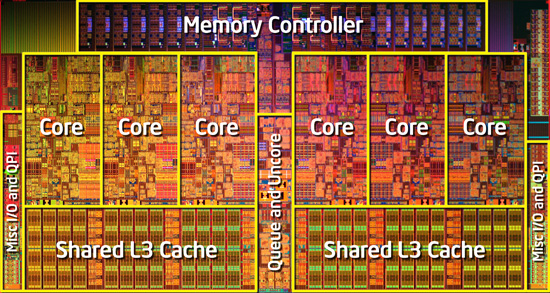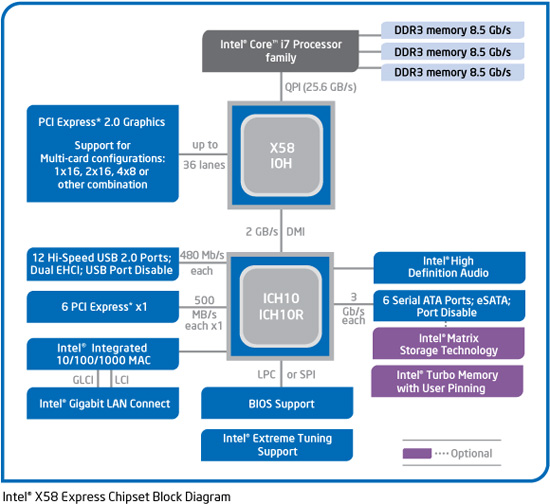The Core i7 980X Review: Intel's First 6-Core Desktop CPU
by Anand Lal Shimpi on March 11, 2010 12:00 AM EST- Posted in
- CPUs
A 12MB L3 Cache: 50% Larger, 14% Higher Latency
Gulftown sticks to Ronak’s 2MB of L3 per core rule and has a full, 12MB shared L3 cache that’s accessible by any or all of the six cores. It’s actually because of the large unified L3 cache that performance in applications that don’t use all six cores can be higher than quad-core Core i7s.

Nehalem

Gulftown
The added cache does come at the expense of higher access latency. Nehalem and Lynnfield had a 42-cycle 8MB L3, Gulftown has a 48 cycle 12MB L3. A 14% higher latency for a 50% increase in size. Not an insignificant penalty, but a tradeoff that makes sense.
Identical Power Consumption to the Core i7 975
Raja has been busy with his DC clamp meter measuring actual power consumption of CPUs themselves rather than measuring power consumption at the wall. The results below compare the actual power draw of the 32nm Core i7 980X to the 45nm Core i7 975. These values are just the CPU itself, the rest of the system is completely removed from the equation:
| CPU | Intel Core i7 980X | Intel Core i7 975 |
| Idle | 6.3W | 6.3W |
| Load | 136.8W | 133.2W |
Thanks to power gating, both of these chips idle at 6.3W. That's ridiculous for a 1.17B transistor chip. Under full load, the two are virtually identical - both drawing around 136W.
Westmere Goodness
The Core i7 980X is the first LGA-1366 processor based on Intel’s Westmere architecture, but unlike Clarkdale it does not have an on-die PCIe controller or on-package graphics. If anything, Gulftown really looks like a 6-core, 32nm version of Bloomfield rather than a scaled up Clarkdale. The similarities to Bloomfield extend all the way to the memory controller. Gulftown only officially supports three channels of DDR3-1066 memory, not 1333MHz like Lynnfield or Clarkdale. Of course running DDR3-1333 memory is possible, but the memory controller is technically operating out of spec at that frequency.

The processor does retain the Westmere specific features. The first Core i7 did not power gate its L3 cache, Lynnfield added it and Gulftown has it as well. While Mainly improved power efficiency and AES-NI instructions. I looked at the performance improvement offered by AES-NI acceleration in our Clarkdale review. If you use BitLocker or do a lot of archive encryption/decryption, you'll appreciate Gulftown's AES-NI.










102 Comments
View All Comments
softdrinkviking - Thursday, March 11, 2010 - link
it's a 2-p4 mcm at at a lower node with a lotof improvements over the older p4 manufacturing processes.
if i absolutely had to have netburst, that's what i would want.
i think it's really nice that Anand includes it in the comparison, because it gives a sense of history to the article, and it shows how much faster CPUs have gotten in such a short time.
JonnyDough - Thursday, March 11, 2010 - link
Yep. It might be based on P4, but you can't really considered a P4. It was based on two cedar mill cores rather than smithfield with double the cache and a 200mhz bus speed jump.Dadofamunky - Thursday, March 11, 2010 - link
And exactly the same NetBurst architecture otherwise. And I'm sorry, but seeing that POS coming up with 40% against Gulftown signifies either one of two things: Gulftown isn't that much faster; or, the SysMark software distorts the relative performance results. That isn't a realistic portrayal of 'history.' SysMark 2007 badly needs an update. It isn't a realistic tool for the 4-to-6-core world.danielkza - Thursday, March 11, 2010 - link
Weird, other sites managed to squeeze up to 4.4GHz of the 980X on air, and 4.7GHz on WC. I thought initially of different stability requirements from both parts, but bit-tech ran all their benchmarks at both 4400MHz and 4720MHz. Maybe Anand's DX58 isn't holding up so well after all.http://www.bit-tech.net/hardware/cpus/2010/03/11/i...">http://www.bit-tech.net/hardware/cpus/2...-core-i7...
DanNeely - Thursday, March 11, 2010 - link
Anand only used a stock cooler to test. The intel coolers never have much head room in them. Luck of the draw in both mobo and CPU might be a factor but so is bit-tech's better cooling.chrisfam - Thursday, March 11, 2010 - link
Tomshardware got a 4.13 Ghz overclock with 1.4v and with Enhanced SpeedStep and Turbo Boost enabled. Neoseeker got a 4.16 Ghz overclock with just 1.35v. And both of these were with the stock heat sink.Anand Lal Shimpi - Thursday, March 11, 2010 - link
I've been working on a follow up to go deeper into our overclocked numbers. A motherboard swap later and a little bit of work appears to be paying off...I'm over 4.1GHz already :-)Update soon!
Take care,
Anand
chrisfam - Thursday, March 11, 2010 - link
Updated overclock (4.13 Ghz, 1.359V) is much better. Thanks for the update.Rajinder Gill - Thursday, March 11, 2010 - link
That's right, 3.7-3.8GHz is the full load limit of Intel's stock cooler with these beasts. We ran out of time to really push, but I'm sure we'll find out what these chips can do in due course.regards
Raja
strikeback03 - Thursday, March 11, 2010 - link
Is the new tower cooler an improvement in any way over the old one? Is it quieter, as it doesn't seem to offer more OC headroom.Also, how does the CPU power consumption increase by 130W at load over idle, while system consumption only goes up 90W?